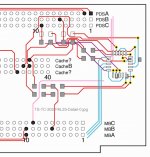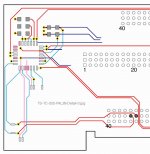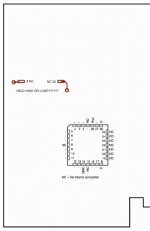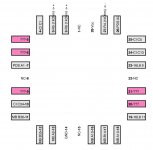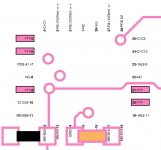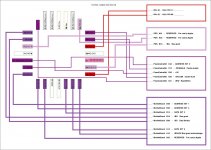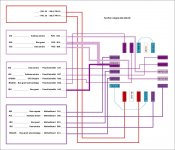This chapter is about done, other than error checking and general research until someone else chimes in. I've gone about as far as I can with this adapter without help, so I guess a project summary for the overall
cloning project is in order:
TwinSlot is a crucial line of research because its adaptation is splayed out across PDS, PDS passthru and the IIci Cache Slot adaptation. It also happens to be needed in two of my ProjectMacs! I wasn't expecting to see those connections to signals reserved for Apple's internal use, at least not the one to the Logic Board, that will likely prove to be problematic. The undocumented RESERVED connections on the adapter were not
entirely unexpected. They could well have been hijacked by DayStar for internal use within the adapter itself with no connection at all to the PDS. That's a rolled up sleeves dirty trick I've considered playing on the motherboard of the IIsi itself using the traces of entire buses for my own nefarious purposes while the CPU thinks they're offline.
I've got adapters for the Mac IIx and the Mac II to model like this as the next steps of the overall Cloning Project. They'll be much easier to unravel as I'll be desoldering the connectors and active components so scans will be available of all traces on the outer layers. There will be little guesswork involved there!

If needs be I can remove ALL components to buzz connections unimpeded by resistors holding signals high or low.
The IIx is interesting because it has only one small GAL on board, so it's far less complicated than the TwinSlot. It lends itself to coming up with an acceptable either/or solution for my two target systems and completes the process of cloning that adapter once we can derive or brute force the truth table secrets lurking within that one simple GAL.
The Mac II PowerCache adapter is fascinating in its complexity because it has a GAL, a PAL and a PROM on board. It plugs directly into the sockets for the discrete 68020 CPU and
68851 MMU on the motherboard. The CPU is removed and socketed on the adapter alongside the connector for DayStar's IIci Cache Slot implementation. The 68851 drops out of the picture at his point as its functions are taken on by the (surprisingly less capable) MMU implemented within the 68030 CPU. The Mac II adapter should actually be less complicated in terms of divining the functions of its three discrete active components because both 68020 and 68851 are fully documented, unlike the the ASICs infesting later iterations of the II series. The only fly in that ointment might be those pesky RESERVED pins on the IIci PDS. Fingers crossed gang!
I'm hopeful that when all three (fortunately that's four with off's confirmation that the IIsi TwinSlot works in his SE/30) Mac's adapter schematic PDFs are printed on legal paper and laid out in column for markup that patterns will become apparent.
Because the Mac IIcx has a passive adapter (no active components) these three PowerCache adapters will complete the puzzle for the entire Macintosh II series architecture other than its IIfx offshoot, it being beyond the ken of mere mortals. As far as I'm concerned it's an elegant black box to be treasured as is. Not to mention that it is one BIG@$$ platinum windmill better given a wide berth, I'm not poking sticks at that sucker!
edit: forgot to mention that I'd REALLY appreciate several of you proofreading my "schematic" of the TwinSlot. Proofreading one's own layout is impossible, contrary to my ex-partner in the sign business. He never could understand that, being impatient about doing it for me on my layouts. :

Checking the tables in off's wonderful
120 Shades of Pins PDF against
my schematic PDF is an absolute necessity.
off, if you could double check your tables and buzzing results it would be much appreciated. Finding out that that RESERVED connection to A2 on the motherboard is an error made by either of us might not be exactly a dream come true, but it sure would be nice to have it turn out to be a nightmare avoided!
Suggestions form those of you conversant in schematic development and in reading the blasted things IRL for turning this graphic representation into a actual schematic presentation would also be much appreciated. Confirmation that it's "good enough" as is would be even better news!


